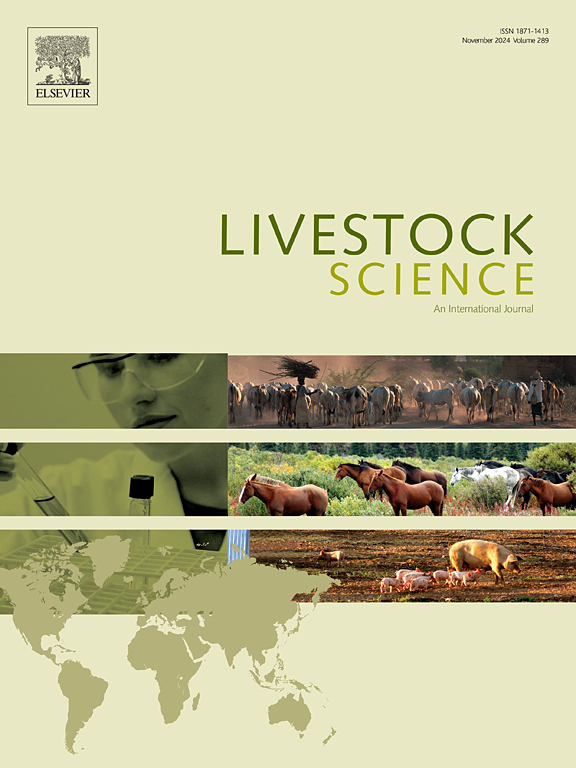Phytase appeared to counterbalance the inimical effect on N balance of acidosis associated with displacing calcium carbonate with calcium chloride in grower pigs
IF 1.9
3区 农林科学
Q2 AGRICULTURE, DAIRY & ANIMAL SCIENCE
引用次数: 0
Abstract
The objective of this study was to evaluate CaCl2 as a Ca source by measuring the balance of Ca, Cl, and P, as well as its effects on plasma and urine chemistry. Six experimental diets were arranged in a 3 × 2 factorial design with 3 Ca sources (limestone, CaCl2, or their 1:1 mixture) and 2 phytase levels (0, and 1,000 FYT/kg). Each diet was fed to 8 individually housed barrows in metabolism cages, totaling 48 pigs for the study. Fecal and urinary samples were collected quantitatively for 5 days following a 5-day adaptation period. Blood samples were collected from the vena cava at the end of the study. The results showed that plasma glucose concentration was significantly higher in pigs fed CaCl2 than in pigs fed only limestone. Gradually replacing limestone with CaCl2 tended to increase plasma concentrations of amylase, K, Na, and P. The supplemental phytase significantly increased plasma P concentration but reduced plasma Ca and blood urea nitrogen concentrations. Urinary pH was significantly lower in pigs fed only CaCl2 compared to other pigs. Phytase supplementation significantly reduced urinary concentration of Ca, and tended to reduce urinary concentration of N and to increase urinary concentration of P. Increasing inclusion of CaCl2 in place of limestone resulted in stepwise increases in the apparent total tract digestibility and retention of Ca and P. The Cl intake, output through feces and urine, and retention increased stepwise with higher levels of CaCl2 (P < 0.05). Phytase significantly decreased Ca and P output through feces and increased their retention. There was a decrease in retention of CP in diet including only CaCl2 compared to other diets without phytase, but an increase in the presence of phytase. In conclusion, the current study shows that CaCl2 has higher Ca bioavailability than limestone and can reduce urinary pH, potentially reducing emission of NH3 from slurry. However, the accumulation of Cl in pigs can disrupt the systemic acid-base balance and might cause damage to some organs such as the pancreas. Therefore, CaCl2 can be used as a Ca source only if its Cl contribution does not endanger dietary electrolyte balance. Additionally, phytase appeared to ameliorate the inimical effect of acidosis associated with CaCl2 supplementation on N balance.
植酸酶似乎可以抵消生长猪用氯化钙取代碳酸钙所引起的酸中毒对氮平衡的不利影响。
本研究的目的是通过测量钙、氯和磷的平衡,以及它对血浆和尿液化学的影响,来评估CaCl2作为钙源的作用。6种试验饲粮采用3 × 2因子设计,3种钙源(石灰石、CaCl2或它们1:1的混合物)和2种植酸酶水平(0和1000 FYT/kg)。每种饲粮分别饲喂8头单独饲养的代谢笼,共48头猪。在5 d的适应期后,定量收集5 d的粪便和尿液样本。在研究结束时,从腔静脉采集了血液样本。结果表明,饲喂CaCl2的猪血浆葡萄糖浓度显著高于单纯饲喂石灰石的猪。添加植酸酶可显著提高血浆中淀粉酶、钾、钠和磷的浓度,但可显著降低血浆钙和血尿素氮浓度。与其他猪相比,仅饲喂CaCl2的猪尿液pH值显著降低。添加植酸酶可显著降低尿钙浓度,并有降低尿氮浓度和增加尿磷浓度的趋势。添加钙l2代替石灰石可使钙和磷的全消化道表观消化率和潴留逐步增加。随着钙l2水平的提高,通过粪便和尿液摄入、排出的Cl和潴留逐渐增加(P <;0.05)。植酸酶显著降低粪便中钙、磷的排泄量,增加其滞留量。与不含植酸酶的饲料相比,仅含CaCl2的饲料中CP的保留率降低,但植酸酶的存在增加。综上所述,本研究表明,CaCl2比石灰石具有更高的Ca生物利用度,可以降低尿液pH值,从而有可能减少尿浆中NH3的排放。然而,猪体内氯的积累会破坏全身酸碱平衡,并可能对某些器官(如胰腺)造成损害。因此,CaCl2只有在不危及膳食电解质平衡的情况下才能作为钙源。此外,植酸酶似乎可以改善与补充CaCl2相关的酸中毒对氮平衡的不利影响。
本文章由计算机程序翻译,如有差异,请以英文原文为准。
求助全文
约1分钟内获得全文
求助全文
来源期刊

Livestock Science
农林科学-奶制品与动物科学
CiteScore
4.30
自引率
5.60%
发文量
237
审稿时长
3 months
期刊介绍:
Livestock Science promotes the sound development of the livestock sector by publishing original, peer-reviewed research and review articles covering all aspects of this broad field. The journal welcomes submissions on the avant-garde areas of animal genetics, breeding, growth, reproduction, nutrition, physiology, and behaviour in addition to genetic resources, welfare, ethics, health, management and production systems. The high-quality content of this journal reflects the truly international nature of this broad area of research.
 求助内容:
求助内容: 应助结果提醒方式:
应助结果提醒方式:


